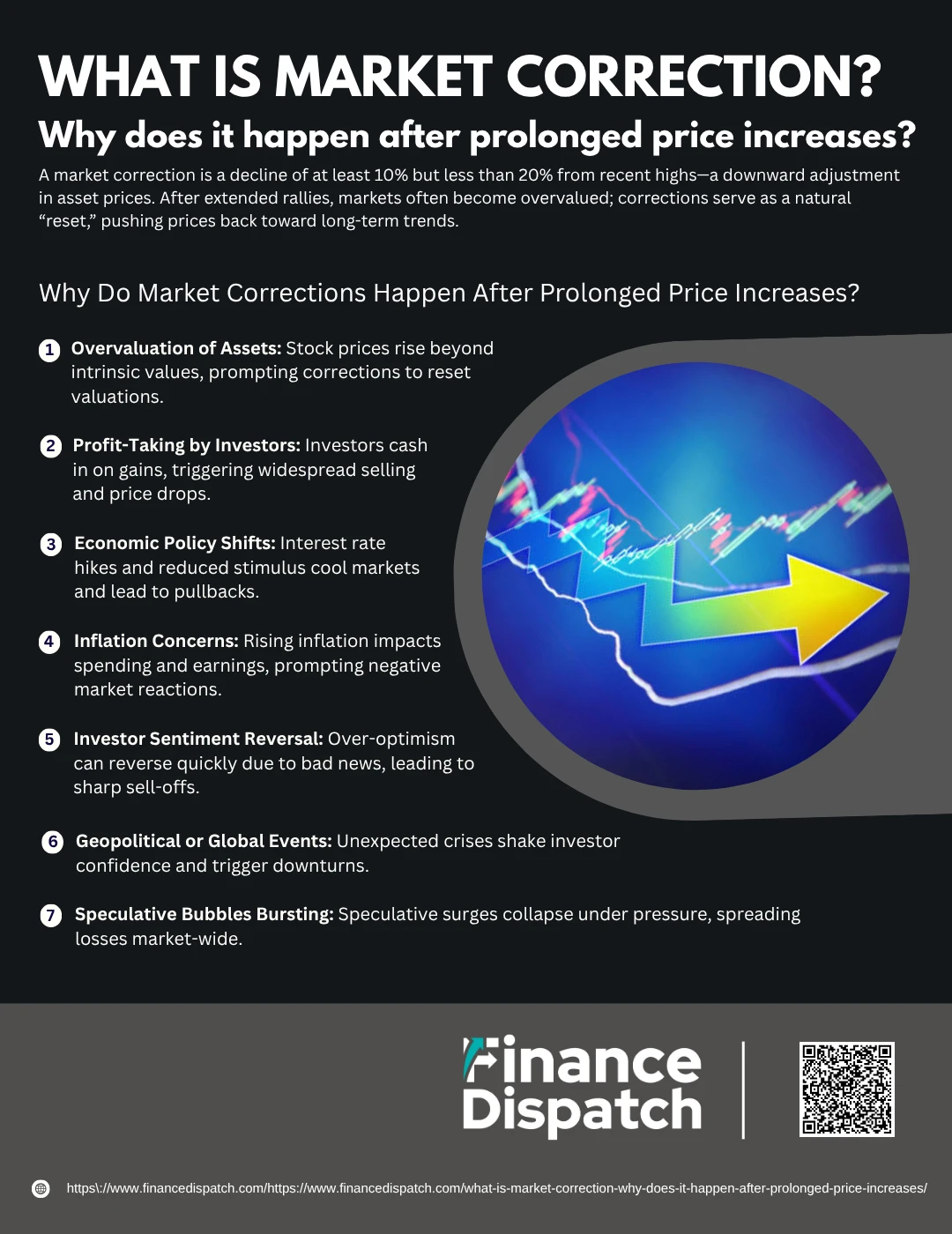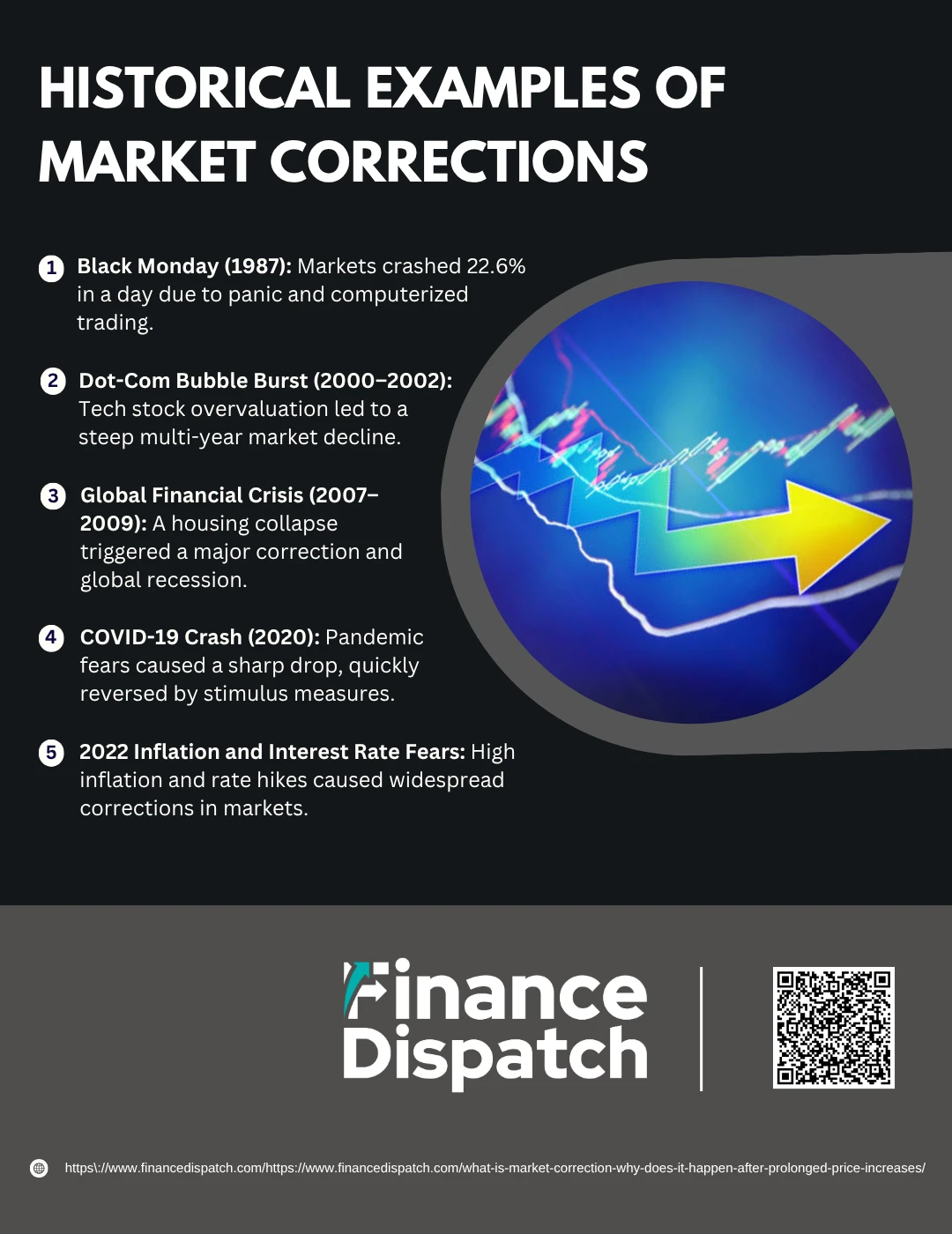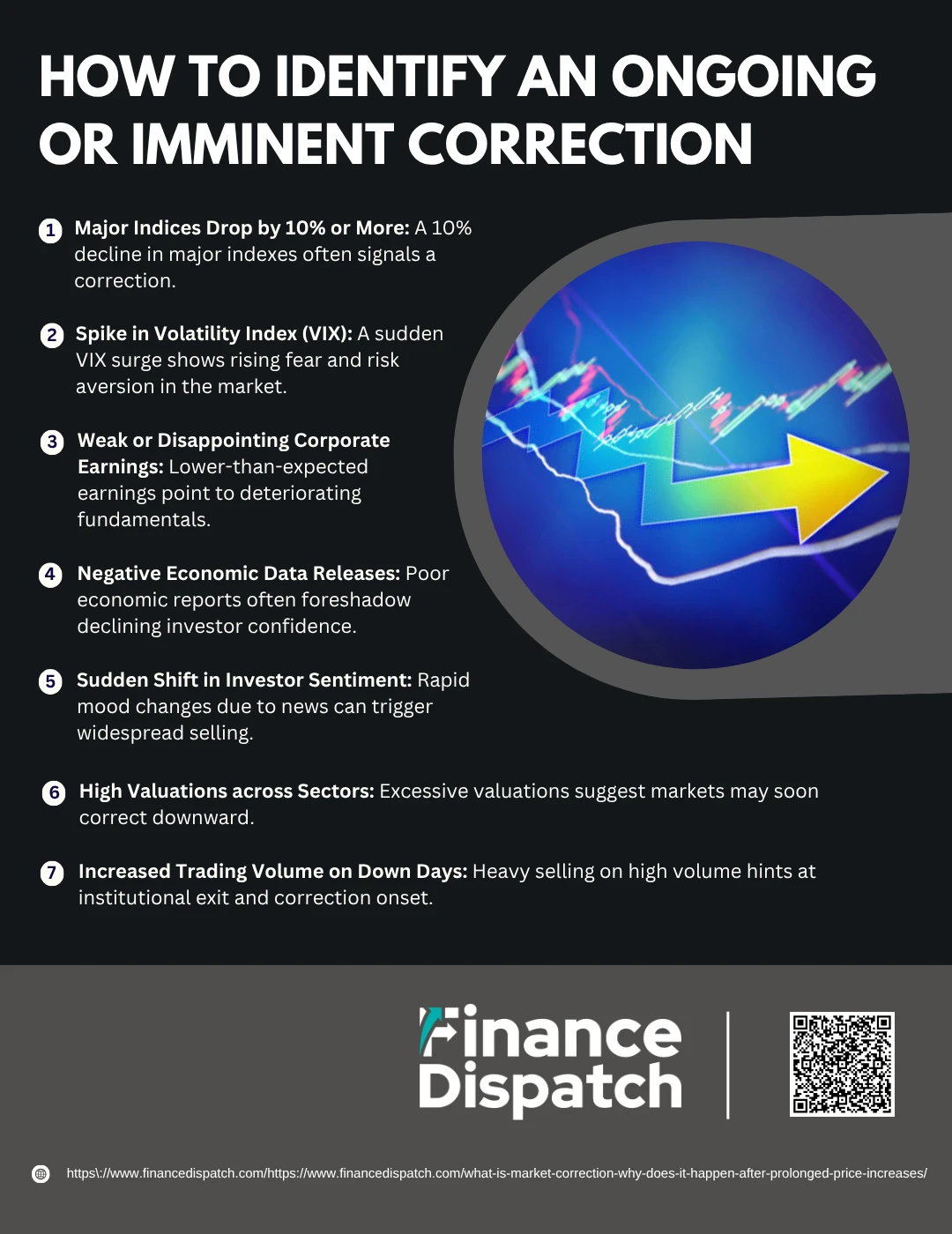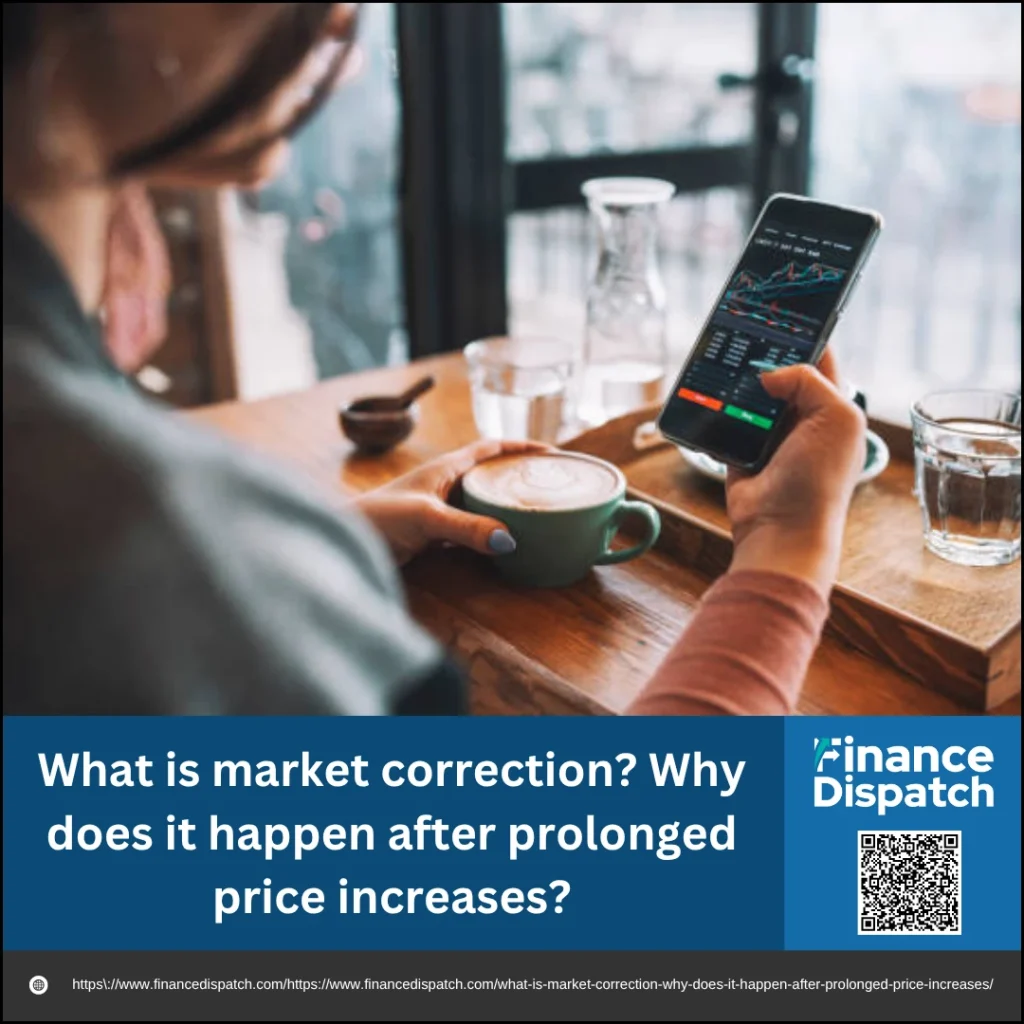When markets soar to new highs, the excitement can be contagious—but it often comes with a hidden risk: overvaluation. That’s where a market correction steps in. A market correction is a natural, sometimes necessary, pause in a prolonged upward trend—typically marked by a drop of 10% or more in asset prices. While the term may sound alarming, corrections help restore balance by adjusting inflated prices closer to their true value. In this article, we’ll explore what a market correction is, why it often follows extended price increases, and how understanding this phenomenon can empower smarter, calmer investment decisions.
What Is a Market Correction?
A market correction is a temporary decline in the value of financial assets—most commonly stocks—typically defined by a drop of at least 10% from a recent peak. Unlike a bear market, which involves a deeper and more prolonged downturn, corrections are shorter in duration and often serve as a healthy recalibration after an extended period of rising prices. They occur across various asset classes, including equities, real estate, and cryptocurrencies, and are seen as a way for markets to adjust inflated valuations to more sustainable levels. Though unsettling in the short term, corrections are a normal part of the market cycle and often signal future opportunities for long-term investors.
 Why Do Market Corrections Happen After Prolonged Price Increases?
Why Do Market Corrections Happen After Prolonged Price Increases?
After a prolonged rise in stock prices, it’s easy for investors to believe the market will keep climbing. But this upward momentum often builds on optimistic sentiment rather than fundamental value. Over time, prices can become inflated beyond what companies are truly worth. A market correction occurs as a natural counterbalance, realigning overvalued assets with more reasonable expectations. Corrections help cool overheated markets, reduce the risk of bubbles, and provide long-term investors with opportunities to buy at more attractive prices. Understanding why these corrections occur can help investors stay grounded and make smarter decisions when markets become volatile.
Here are the key reasons why market corrections tend to happen after extended price increases:
1. Overvaluation of Assets
Extended rallies can push stock prices far above their intrinsic value. When price-to-earnings ratios and other valuation metrics become unsustainably high, a correction helps reset them closer to historical norms.
2. Profit-Taking by Investors
After significant gains, many investors begin selling to secure their profits. When enough investors do this at the same time, selling pressure outweighs buying demand, leading to a broad decline in prices.
3. Economic Policy Shifts
Central banks may increase interest rates or reduce monetary stimulus to prevent the economy from overheating. These actions make borrowing more expensive and can slow down consumer and business spending, dampening market enthusiasm.
4. Inflation Concerns
Persistent inflation cuts into consumer purchasing power and increases operational costs for businesses. When inflation fears rise, markets often respond negatively, anticipating tighter monetary policy or lower corporate earnings.
5. Investor Sentiment Reversal
In bullish markets, investors may become overly optimistic. But this sentiment can shift quickly due to bad news—such as poor earnings, economic data, or geopolitical tensions—prompting fear-driven sell-offs.
6. Geopolitical or Global Events
Wars, pandemics, political instability, or trade conflicts introduce uncertainty. Even when markets are strong, unexpected global events can shake investor confidence and lead to a sudden downturn.
7. Speculative Bubbles Bursting
During prolonged rallies, speculative behavior increases—particularly in riskier assets like tech stocks or cryptocurrencies. When reality catches up and the bubble bursts, the sell-off can spread across broader markets, triggering a correction.
 Historical Examples of Market Corrections
Historical Examples of Market Corrections
Market corrections are not rare anomalies—they are a recurring feature of financial markets. Throughout history, investors have witnessed several periods where asset prices surged beyond sustainable levels and were followed by sharp pullbacks. These corrections often emerged in response to economic shifts, investor panic, or global crises, but they also served a valuable purpose: to recalibrate the market. Looking back at past corrections provides insight into how markets behave and recover, helping investors prepare for future downturns with greater confidence.
Here are some notable historical examples of market corrections:
1. Black Monday (1987)
On October 19, 1987, U.S. stock markets experienced their largest single-day percentage drop in history. The Dow Jones Industrial Average plummeted by 22.6% amid computerized trading and investor panic. Despite the shock, markets began recovering within days.
2. Dot-Com Bubble Burst (2000–2002)
Following years of exuberant tech stock buying, the Nasdaq Composite lost nearly 78% of its value over two years. Overvaluation and speculative investments drove prices far above reality, and when earnings didn’t materialize, a major correction followed.
3. Global Financial Crisis (2007–2009)
Triggered by the collapse of the U.S. housing market and financial institutions, this correction turned into a bear market. The S&P 500 lost over 50% of its value, but also demonstrated the resilience of markets, eventually recovering and reaching new highs.
4. COVID-19 Crash (2020)
In early 2020, pandemic fears and lockdowns sent markets into a freefall. The S&P 500 dropped over 30% in a matter of weeks, marking one of the fastest corrections in history. Swift government stimulus and monetary policy helped the market rebound within months.
5. 2022 Inflation and Interest Rate Fears
After years of pandemic-era stimulus and low interest rates, inflation surged globally in 2022. Central banks responded with aggressive rate hikes, leading to a significant correction in both stock and bond markets. This period reminded investors how sensitive markets are to monetary tightening.
Correction vs. Bear Market vs. Crash
Not all market downturns are created equal. When prices fall, it’s important for investors to understand whether they’re facing a correction, a bear market, or a crash—each has distinct characteristics and implications. While a correction is typically short and sharp, a bear market lasts longer and reflects deeper economic issues. A crash, on the other hand, is sudden, steep, and often emotionally charged. Distinguishing between these events can help investors respond with the right strategy rather than reacting out of fear.
Here’s a comparison of a correction, a bear market, and a crash:
| Feature | Correction | Bear Market | Market Crash |
| Definition | Decline of 10% or more from a peak | Decline of 20% or more from a peak | Sudden drop of 20% or more in a very short time |
| Duration | Weeks to a few months | Several months to years | Days to weeks |
| Cause | Overvaluation, sentiment shift | Economic downturn, recession | Panic selling, extreme events |
| Market Behavior | Temporary and healthy pullback | Sustained downward trend | Abrupt and chaotic sell-off |
| Investor Impact | Short-term volatility | Long-term loss in confidence and value | High fear, possible systemic risk |
| Recovery Time | Quick, usually within months | Gradual, often over years | Varies—can be fast or slow |
| Examples | 2022 Rate Hike Correction | 2008 Financial Crisis | 1987 Black Monday, COVID-19 (initial crash) |
 How to Identify an Ongoing or Imminent Correction
How to Identify an Ongoing or Imminent Correction
Market corrections can feel sudden, but they often follow subtle shifts in market behavior, investor sentiment, and economic indicators. While it’s impossible to time a correction with precision, being able to spot the signs early can give you a psychological and strategic edge. Investors who understand the typical warning signals are better equipped to ride out short-term volatility without panic selling or making rushed decisions. Recognizing the difference between normal fluctuations and a brewing correction is key to protecting and positioning your portfolio effectively.
Here are some common ways to identify an ongoing or imminent market correction, with added detail:
1. Major Indices Drop by 10% or More
When benchmarks like the S&P 500, Nasdaq, or Dow Jones fall at least 10% from their recent highs, a correction is generally considered to be underway. This drop may occur gradually over several days or weeks, or more quickly during heightened volatility.
2. Spike in Volatility Index (VIX)
The VIX measures market volatility expectations. A sudden rise in the VIX often reflects growing fear and uncertainty among investors, indicating that market sentiment is shifting toward risk aversion—a common trait in the early stages of corrections.
3. Weak or Disappointing Corporate Earnings
Earnings season provides a pulse on business performance. If a large number of companies report below-expected profits or offer cautious outlooks, it may signal weakening fundamentals that can trigger a broader market pullback.
4. Negative Economic Data Releases
Slowing GDP growth, rising inflation, declining retail sales, or increasing unemployment claims can indicate that the broader economy is under pressure—conditions that often lead to declining investor confidence and a market correction.
5. Sudden Shift in Investor Sentiment
Even in the absence of hard data, changes in mood—from optimism to caution—can move markets. Headlines about war, regulatory crackdowns, or financial instability in key sectors often act as catalysts that quickly shift investor behavior.
6. High Valuations Across Sectors
When markets rise for a prolonged period, valuations (like price-to-earnings ratios) can stretch far beyond historical averages. At some point, investors may feel the prices are unjustified, prompting a sell-off that leads to a correction.
7. Increased Trading Volume on Down Days
Watching volume patterns can offer clues. When market declines are accompanied by unusually high trading volumes, it indicates broad and forceful selling pressure. This is often a sign that institutional investors are reducing exposure.
Psychological Impact on Investors
The psychological impact of a market correction on investors can be profound. As asset prices begin to decline, fear and uncertainty often take over, leading to emotional decision-making. Investors may experience panic, anxiety, or a strong urge to sell in order to “cut losses,” even when the downturn is temporary. This behavior is often driven by cognitive biases such as loss aversion—the tendency to feel the pain of losses more intensely than the pleasure of gains. Media headlines amplifying the negativity can further heighten stress and cause rational thinking to be replaced by reactive choices. Unfortunately, acting on these emotions can lead to selling at low points and missing out on eventual recoveries, which erodes long-term returns. Understanding this psychological toll is essential for investors who want to remain disciplined and stay focused on long-term goals during turbulent times.
How to Navigate Market Corrections Smartly
Navigating a market correction can be challenging, especially when prices fall rapidly and uncertainty takes over. However, smart investors understand that corrections are a natural part of market cycles and often present opportunities rather than threats. Instead of reacting impulsively, applying thoughtful strategies can help protect your portfolio and position it for long-term success. Here are practical ways to handle market corrections wisely:
1. Stay Calm and Avoid Panic Selling
Emotional reactions like panic selling can lock in losses and derail long-term plans. Maintain perspective and remember that corrections are usually temporary.
2. Review and Rebalance Your Portfolio
Use the opportunity to check if your asset allocation aligns with your risk tolerance and financial goals. Rebalancing can help manage risk and restore balance.
3. Maintain a Long-Term Mindset
Focus on your investment horizon. If your goals are years away, short-term dips shouldn’t shake your confidence.
4. Look for Buying Opportunities
Corrections often bring down prices of quality assets. Consider adding fundamentally strong stocks at discounted valuations if it fits your strategy.
5. Ensure Diversification
A diversified portfolio helps cushion the impact of downturns. Spreading investments across asset classes can reduce overall volatility.
6. Avoid Trying to Time the Market
Predicting the exact bottom is nearly impossible. Time in the market usually outperforms trying to time the market.
7. Keep Cash or Emergency Funds Ready
Having liquid assets allows you to avoid selling investments in a downturn and gives you flexibility to take advantage of low prices.
Are Corrections Predictable?
Market corrections are notoriously difficult to predict. While analysts and investors may spot signs of overvaluation or economic stress, pinpointing the exact timing, magnitude, or trigger of a correction is nearly impossible. Corrections can arise suddenly from unforeseen events—like geopolitical conflicts, natural disasters, or a shift in investor sentiment—and may happen even when the broader economy appears stable. Even seasoned professionals often get the timing wrong. This unpredictability highlights the importance of preparation over prediction. Rather than trying to forecast corrections, successful investors focus on building resilient, well-diversified portfolios that can weather short-term volatility and deliver steady returns over the long run.
Conclusion
Market corrections are an inevitable and essential part of the investing journey. While they can be unsettling, understanding their causes, recognizing early warning signs, and maintaining a long-term perspective can turn these temporary downturns into valuable opportunities. Rather than fearing corrections, investors should view them as moments to reassess portfolios, reinforce discipline, and potentially invest in quality assets at lower prices. With the right mindset and strategy, market corrections become less of a threat and more of a tool for achieving lasting financial growth.



